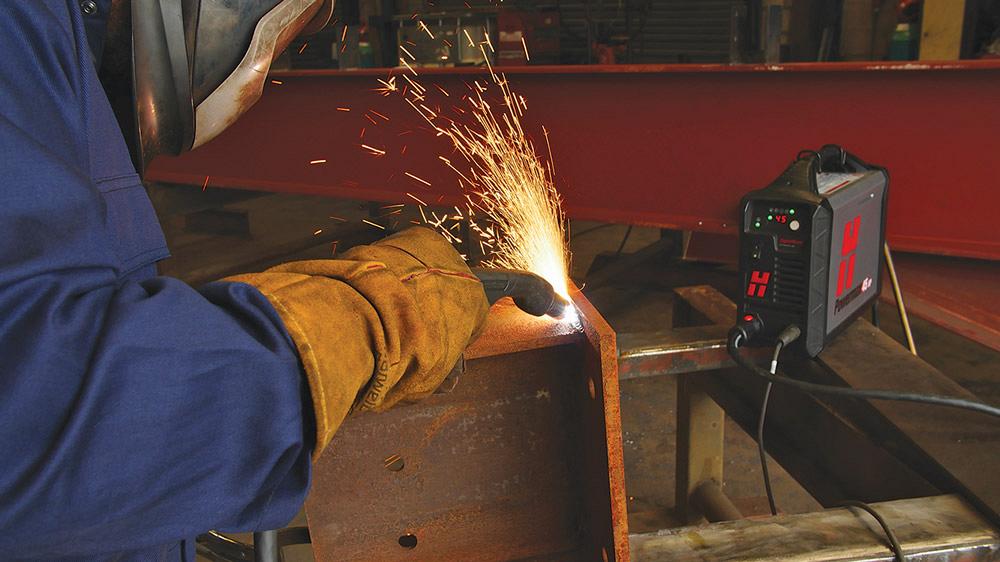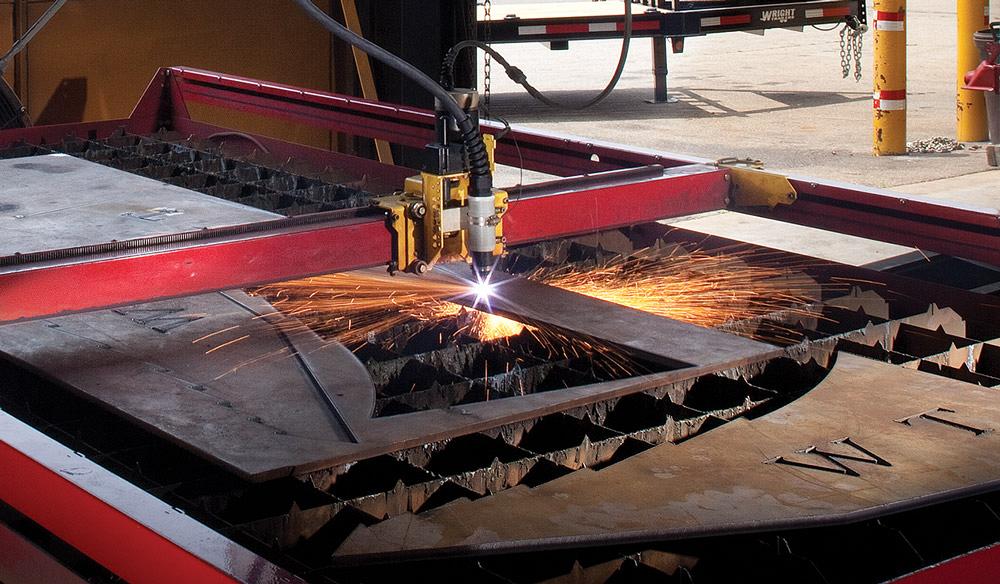Consultant
- FMA
- The Fabricator
- FABTECH
- Canadian Metalworking
Categories
- Additive Manufacturing
- Aluminum Welding
- Arc Welding
- Assembly and Joining
- Automation and Robotics
- Bending and Forming
- Consumables
- Cutting and Weld Prep
- Electric Vehicles
- En Español
- Finishing
- Hydroforming
- Laser Cutting
- Laser Welding
- Machining
- Manufacturing Software
- Materials Handling
- Metals/Materials
- Oxyfuel Cutting
- Plasma Cutting
- Power Tools
- Punching and Other Holemaking
- Roll Forming
- Safety
- Sawing
- Shearing
- Shop Management
- Testing and Measuring
- Tube and Pipe Fabrication
- Tube and Pipe Production
- Waterjet Cutting
Industry Directory
Webcasts
Podcasts
FAB 40
Advertise
Subscribe
Account Login
Search
Understanding the plasma cutting duty cycle in welding
What it is, what it means, why it’s important
- By Jim Colt
- Updated August 10, 2023
- March 8, 2017
- Article
- Cutting and Weld Prep

Determining duty cycle is tricky because there is no universal industry standard among manufacturers. Though duty cycle is not all that complicated, a thorough understanding of it can help protect you and your investment.
Often plasma cutting duty cycle is merely an afterthought. When you place your focus on a system’s power level, performance capability, and price when making purchasing decisions, you tend to overlook its duty cycle and how it was determined.
Though duty cycle is not all that complicated, a thorough understanding of it can help protect you and your investment. There’s nothing more frustrating than spending hundreds of dollars on equipment only to discover later that it won’t meet your needs.
What Is Duty Cycle in Welding?
Whether it is a plasma cutting machine or another electrical tool, duty cycle represents the percentage of time the machine can operate in a given period. For plasma cutters, that time period is 10 minutes. For example, a system with 30 percent duty cycle simply means the plasma arc can remain on without causing the system to overheat for 3 out of every 10 minutes. A system with a 50 percent duty cycle is able to operate for 5 of 10 minutes, and so on.
Many plasma and welding manufacturers use International Electrotechnical Commission (IEC) standards when establishing duty cycle. These standards are based on a known ambient temperature of 104 degrees F (40 degrees C). Here’s what the test looks like:
- The power supply is brought up to 104 degrees F.
- Cutting is performed at the system’s maximum current at a fixed arc voltage.
- When the components inside the power supply (transformers and switching devices) reach the manufacturer’s maximum operating temperature, you have reached duty cycle.
Temperature sensors installed by most manufacturers kick in and shut down the system automatically before damage occurs.
While duty cycle may not be much of a concern for the occasional hobbyist, it becomes a concern anytime you put a plasma system on a CNC machine, as you can expect higher arc-on times than when cutting by hand.
How Is a Welding Duty Cycle Determined?
Determining duty cycle is tricky because, again, there is no universal industry standard among plasma and welding equipment manufacturers. In fact, manufacturers can and do use different inputs in order to state a higher duty cycle. So how do you know if a particular system will meet your needs? You can start by looking at the ambient temperature that the duty cycle is based on and then the load voltage of the system.
Ambient Temperature. Manufacturer A uses an ambient temperature of 70 degrees F while manufacturer B uses the IEC-suggested temperature of 104 degrees. In this case, manufacturer A will come up with a higher duty cycle because its system doesn’t have to work as hard as the system from manufacturer B. It’s like how our bodies behave when going for a run—we can run a lot farther on a mild 70-degree day than we can on a hot 104-degree day.
Load Voltage. If manufacturer A determines duty cycle when the system is cutting thin-gauge material, while manufacturer B is running the system at maximum capacity, which manufacturer do you think will come up with a better duty cycle rating? Again, like our bodies, we can carry 1 pound a lot farther than 20 or 30 lbs.
So even though a manufacturer may state that its machine has a 60 percent duty cycle, you may never see that. You could easily experience a duty cycle far below that by simply working your system harder than the manufacturer did during testing, or by using your system in an area that is warmer than the temperature used during testing. This happens more often than you think. A consumer will buy a system with a 50 percent duty cycle only to find out later that the percentage is unattainable.

The duty cycle that will best suit you depends on the type of cutting you are doing. Generally, a 50 percent duty cycle is more than sufficient if you are cutting by hand, as there is only so much cutting a person can realistically do.
The good news is you can protect yourself. Most plasma manufacturers list the temperature and arc voltage used to arrive at a given duty cycle. If they don’t, you are right to be suspicious and should ask to see those numbers.
Calculating the Duty Cycle You Need
Now that you know how manufacturers arrive at a duty cycle, the next question is what duty cycle do you really need? It depends on the type of cutting you are doing. Generally, a 50 percent duty cycle is more than sufficient if you are cutting by hand, as there is only so much cutting a person can realistically do.
However, for mechanized cutting in which a system may be operating for long stretches of time, 50 percent duty cycle may not be enough. Does this mean that you should dismiss any system with a 50 percent duty cycle rating? No, but it does mean you may have to buy a larger system and run it at a lower amperage level to achieve a higher duty cycle.
Remember, the best way to evaluate whether a machine’s duty cycle will be sufficient for your needs is to check its ambient temperature and load voltage. You must also take into account the application, be it manual or mechanized, as each has a very different arc-on time. These considerations will lead you to identifying a unit that will perform well and meet your desired cutting needs.

If you are cutting with a mechanized plasma system, 50 percent duty cycle may not be enough. This doesn’t mean that you should dismiss any system with a 50 percent duty cycle rating, but it does mean you may have to buy a larger system and run it at a lower amperage level to achieve a higher duty cycle.
About the Author
About the Publication
Related Companies
subscribe now

The Welder, formerly known as Practical Welding Today, is a showcase of the real people who make the products we use and work with every day. This magazine has served the welding community in North America well for more than 20 years.
start your free subscription- Stay connected from anywhere

Easily access valuable industry resources now with full access to the digital edition of The Fabricator.

Easily access valuable industry resources now with full access to the digital edition of The Welder.

Easily access valuable industry resources now with full access to the digital edition of The Tube and Pipe Journal.
- Podcasting
- Podcast:
- The Fabricator Podcast
- Published:
- 04/16/2024
- Running Time:
- 63:29
In this episode of The Fabricator Podcast, Caleb Chamberlain, co-founder and CEO of OSH Cut, discusses his company’s...
- Trending Articles
Sheffield Forgemasters makes global leap in welding technology

Welding student from Utah to represent the U.S. at WorldSkills 2024

Lincoln Electric announces executive appointments

Engine-driven welding machines include integrated air compressors

ESAB unveils Texas facility renovation

- Industry Events
16th Annual Safety Conference
- April 30 - May 1, 2024
- Elgin,
Pipe and Tube Conference
- May 21 - 22, 2024
- Omaha, NE
World-Class Roll Forming Workshop
- June 5 - 6, 2024
- Louisville, KY
Advanced Laser Application Workshop
- June 25 - 27, 2024
- Novi, MI


























